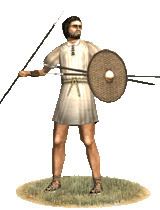Similar Peltast, Thyreophoroi, Thorakitai, Hypaspists, Ekdromoi | ||
In Ancient Greek warfare, psiloi (Ancient Greek ψιλοί, plural of ψιλός, psilos, literally “bare, stripped”), were extremely light infantry who acted as skirmishers and missile troops.
Contents

Psiloi, often used as a broad term to describe types of unarmored or lightly armored infantry, have often been more explicitly referred to by other names, such as gymnetes (lit. naked) or euzonoi (light armored; after whom the modern Evzones are named), grosphomachoi and akontistai (javelineers), sphendonetai (slingers), toxotai (bowmen or archers) or lithoboloi (stone throwers). The peltastai (bearers of light shields, targeteers) are often categorized as an intermediary infantry type, later grouped either with the psiloi or the heavy infantry, according to their main tactical role.
In Greek and Byzantine literature, the psiloi are light troops equipped with missiles, able to fight irregularly in a loose formation.

Ancient Greece
In ancient Greece, the psiloi usually belonged to the poorest citizen classes; sometimes even unfree conscripts would be employed, such as the Peloponnesian helots. They were armed with a variety of missile weapons, such as the bow (toxa), javelin (akontia), sling (sfendonai) or even stones (lithoi). For defense, they had no armor and usually no shield, but would be equipped with a dagger or shortsword.

The psiloi were trained as skirmishers. Their task was to harass the enemy phalanx before the clash, to try to provoke disorder and protect their own lines from enemy skirmishers. They would be sent to occupy imposing terrain around and within the battlefield, as well as to disrupt the enemy in any way during his march, deployment or encampment. Just before the charge of the line, the psiloi would be recalled through the phalanx and deployed behind it or on its wings. They would avoid close combat with more heavily armed opponents unless they had the advantage of especially favorable terrain.
Byzantine Empire

Byzantine military treatises call all light troops psiloi, regardless of their defensive equipment. They were still used as skirmishers, but they were often deployed in regular lines behind or among the heavy infantry ranks, usually equipped with bows.
Examples of use in battle

The most successful use of psiloi against hoplites was in the Battle of Sphacteria, where a huge number of Athenian psiloi eliminated a force of Spartan hoplites.
